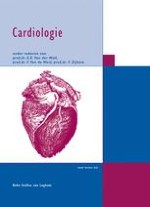Gepubliceerd in:
2008 | OriginalPaper | Hoofdstuk
33 Ventriculaire ritmestoornissen
Samenvatting
Ventriculaire ritmestoornissen (ventriculaire aritmieën) ontstaan in de ventrikels, distaal van de bifurcatie van de bundel van His. De normale hartfrequentie, die meestal door de sinusknoopdepolarisatie wordt gegenereerd, ligt tussen 50 en 100 slagen/min. Deze waarden worden gemeten bij een gezonde persoon die ten minste enkele minuten rust heeft genomen en niet slaapt. Waarden < 50 slagen/min worden bradyaritmieën genoemd en > 100 slagen/min tachyaritmieën. Indien een ritme in het ventrikel ontstaat en een frequentie heeft van minder dan 50 slagen/min, is er sprake van een escaperitme als gevolg van een trage of afwezige activatie van het ventrikel vanuit supraventriculaire structuren, meestal door een atrioventriculair blok. In de bundeltakken is de escapefrequentie dikwijls hoger dan meer distaal in het purkinjesysteem. Distaal in het geleidingssysteem, en zeker in het ventrikelmyocard zelf, kan de escapefrequentie < 40 slagen/ min zijn. Een ritme uit het ventrikel met een frequentie van 50 tot 100 slagen/min is dus geen escaperitme en wordt aangeduid met de term ‘accelerated idioventricular rhythm’ (AIVR). Een dergelijk ritme kan bijvoorbeeld optreden bij een acuut hartinfarct. Bij een frequentie > 100 slagen/min spreekt men van ventrikeltachycardie.
